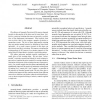Free Online Productivity Tools
i2Speak
i2Symbol
i2OCR
iTex2Img
iWeb2Print
iWeb2Shot
i2Type
iPdf2Split
iPdf2Merge
i2Bopomofo
i2Arabic
i2Style
i2Image
i2PDF
iLatex2Rtf
Sci2ools
SP
2008
IEEE
2008
IEEE
Casting out Demons: Sanitizing Training Data for Anomaly Sensors
The ef’¼ücacy of Anomaly Detection (AD) sensors depends heavily on the quality of the data used to train them. Arti’¼ücial or contrived training data may not provide a realistic view of the deployment environment. Most realistic data sets are dirty; that is, they contain a number of attacks or anomalous events. The size of these high-quality training data sets makes manual removal or labeling of attack data infeasible. As a result, sensors trained on this data can miss attacks and their variations. We propose extending the training phase of AD sensors (in a manner agnostic to the underlying AD algorithm) to include a sanitization phase. This phase generates multiple models conditioned on small slices of the training data. We use these ŌĆ£micromodelsŌĆØ to produce provisional labels for each training input, and we combine the micro-models in a voting scheme to determine which parts of the training data may represent attacks. Our results suggest that this phase automatically and signi’¼...
| Added | 01 Jun 2010 |
| Updated | 01 Jun 2010 |
| Type | Conference |
| Year | 2008 |
| Where | SP |
| Authors | Gabriela F. Cretu, Angelos Stavrou, Michael E. Locasto, Salvatore J. Stolfo, Angelos D. Keromytis |
Comments (0)

